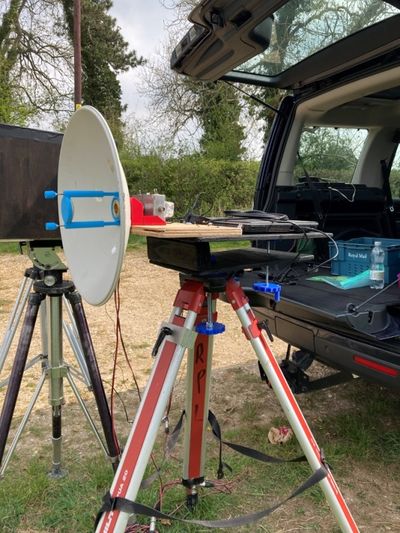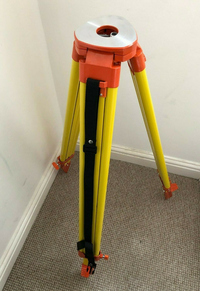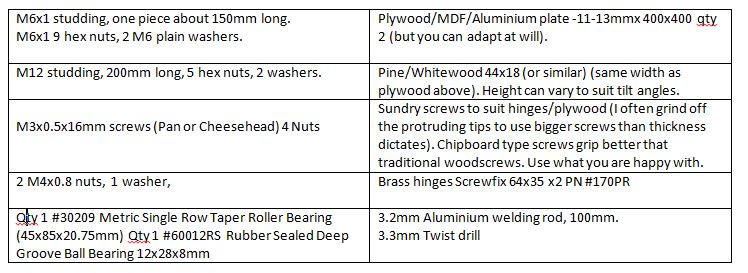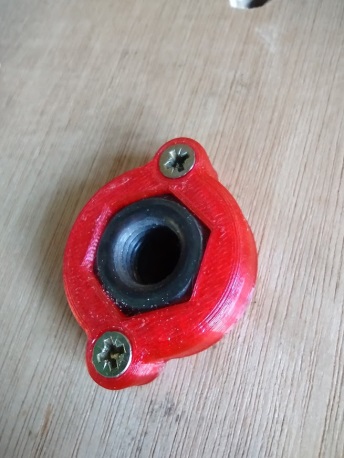Difference between revisions of "Tilt-O-Matic"
(→step 1) |
|||
| Line 29: | Line 29: | ||
=Assembly= | =Assembly= | ||
| − | == | + | ==Step 1== |
| + | |||
| + | A 12mm hole should be drilled in the bottom plywood plate. As it will be the ‘centre of rotation’ you may choose where it is located, centrally or offset front/back depending on your expected headload balance point. I have two, one front mounted, one centrally. | ||
| + | |||
| + | Careful setting of the tripod leg orientation and angle can also affect ultimate stability. Press a 12mm nut into the holder and secure to the TOP face of your BOTTOM plate, centred over the 12mm hole previously drilled. (Hint, screw in the studding to centralise it around the plywood hole before you put the retaining screws in). | ||
| + | |||
| + | [[File:tom 4.jpg|400px]] | ||
| + | |||
| + | ==Step 2 securing the main bearing== | ||
| + | |||
| + | Press the main bearing outer into the large collar such that the taper angle will trap the bearing centre against the plywood when secured with the four securing screw holes . | ||
| + | |||
| + | The plastic ring should be a reasonable grip fit on the bearing outer as it is part of the rotation damping effect. If you want it looser, press out the bearing outer and relieve the inner face of the plastic collar with some abrasive paper. Don’t make it too loose or the bearing may fall out when you remove the table from your tripod (into the mud/sand usually…). | ||
Revision as of 15:25, 27 June 2022
The Tilt-O-Matic (TOM) is an easy to construct pan and tilt mechanism designed by Gareth G4XAT for the ubiquitous yellow / orange surveyor’s tripods which are available for around £35 on the well-known auction site.
The ‘Tilt-O-Matic’ (TOM) provides smooth azimuth rotation with braking (optional) and a tilt mechanism capable of -10 to +10 degrees of tilt (exact limits selectable during the build) with a high degree of precision. Depending on your dish and end-use, the concept can be adapted to suit simply by changing the plywood (base-board) sizes, the height of the vertical separator and the length of the threaded tilt-adjustment rod. Materials have been chosen to be readily available, easy to work, and reasonably priced whiltst offering excellent performance in use.
Construction materials
The .stl files are available on the BATC wiki for the 3D printed parts.
PETG was used for the tilting printed parts, although PLA or PLA+ will also work with less resilience. Print time for the parts sets (print resolution varies depending on function of part/precision required) is around 10 hours and it uses 52m of 1.75mm filament, so about 1/6 of a 1kg roll.
Other materials required:
Mechanical description
The TOM consists of a main bearing assembly which is secured up through the tripod metal top casting (where the theodolite sat) by a 12mm threaded rod into a captive nut mounted on top of the plywood base plate. The bearing is retained by the 3-D printed collar which is secured to the underside of the plywood bottom plate.
The radio equipment is secured to a 2nd plywood plate. I use 8mm nuts, ‘penny’ washers and wingnuts to secure my various antenna/dishes. This top plate is attached by a hinge assembly to the bottom plate to enable the tilt action, controlled by the adjustment mechanism mounted at the end opposite the hinging.
Elevation adjustment is by a threaded rod assembly at the back of the plywood plates and enables elevation adjustment of approximately +10and -10 degrees elevation with a resolution of better than 0.1 degrees.
A small brake assembly (optional) is attached to the underside of one tripod leg and this can be tightened to grip(brake) on the underside of the bottom plywood plate. You can easily add this after trialling the unit. Within reason, additional damping can be obtained by tightening up the bearing clamp turn-wheel, essentially increasing the pre-load on the bearing.
 A ‘TOM’ in use with a 122GHz dish assembly. (Noel G8GTZ)
A ‘TOM’ in use with a 122GHz dish assembly. (Noel G8GTZ)
Assembly
Step 1
A 12mm hole should be drilled in the bottom plywood plate. As it will be the ‘centre of rotation’ you may choose where it is located, centrally or offset front/back depending on your expected headload balance point. I have two, one front mounted, one centrally.
Careful setting of the tripod leg orientation and angle can also affect ultimate stability. Press a 12mm nut into the holder and secure to the TOP face of your BOTTOM plate, centred over the 12mm hole previously drilled. (Hint, screw in the studding to centralise it around the plywood hole before you put the retaining screws in).
Step 2 securing the main bearing
Press the main bearing outer into the large collar such that the taper angle will trap the bearing centre against the plywood when secured with the four securing screw holes .
The plastic ring should be a reasonable grip fit on the bearing outer as it is part of the rotation damping effect. If you want it looser, press out the bearing outer and relieve the inner face of the plastic collar with some abrasive paper. Don’t make it too loose or the bearing may fall out when you remove the table from your tripod (into the mud/sand usually…).



